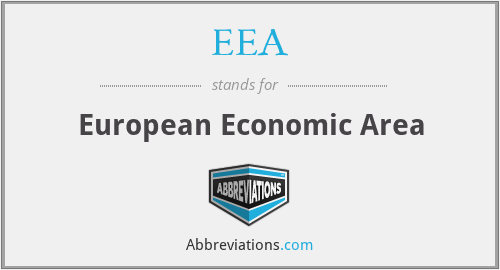What does EEA mean in General Business?
This page is about the meanings of the acronym/abbreviation/shorthand EEA in the Business field in general and in the General Business terminology in particular.
Translation
Find a translation for European Economic Area in other languages:
Select another language:
- - Select -
- 简体中文 (Chinese - Simplified)
- 繁體中文 (Chinese - Traditional)
- Español (Spanish)
- Esperanto (Esperanto)
- 日本語 (Japanese)
- Português (Portuguese)
- Deutsch (German)
- العربية (Arabic)
- Français (French)
- Русский (Russian)
- ಕನ್ನಡ (Kannada)
- 한국어 (Korean)
- עברית (Hebrew)
- Gaeilge (Irish)
- Українська (Ukrainian)
- اردو (Urdu)
- Magyar (Hungarian)
- मानक हिन्दी (Hindi)
- Indonesia (Indonesian)
- Italiano (Italian)
- தமிழ் (Tamil)
- Türkçe (Turkish)
- తెలుగు (Telugu)
- ภาษาไทย (Thai)
- Tiếng Việt (Vietnamese)
- Čeština (Czech)
- Polski (Polish)
- Bahasa Indonesia (Indonesian)
- Românește (Romanian)
- Nederlands (Dutch)
- Ελληνικά (Greek)
- Latinum (Latin)
- Svenska (Swedish)
- Dansk (Danish)
- Suomi (Finnish)
- فارسی (Persian)
- ייִדיש (Yiddish)
- հայերեն (Armenian)
- Norsk (Norwegian)
- English (English)
Definition
What does EEA mean?
- European Economic Area
- The European Economic Area (EEA) was established via the Agreement on the European Economic Area, an international agreement which enables the extension of the European Union's single market to member states of the European Free Trade Association. The EEA links the EU member states and three EFTA states (Iceland, Liechtenstein, and Norway) into an internal market governed by the same basic rules. The United Kingdom benefits from this relationship during the transition/implementation period planned by the treaties. These rules aim to enable free movement of persons, goods, services, and capital within the European Single Market, including the freedom to choose residence in any country within this area. The EEA was established on 1 January 1994 upon entry into force of the EEA Agreement. The contracting parties are the EU, its member states, and Iceland, Liechtenstein, Norway, and the United Kingdom.The EEA Treaty is a commercial treaty and differs from the EU Treaties in certain key respects. According to Article 1 its purpose is to "promote a continuous and balanced strengthening of trade and economic relation". The EFTA members do not participate in the Common Agricultural Policy or the Common Fisheries Policy. The right to free movement of persons between EEA member states and the relevant provisions on safeguard measures are identical to those applying between members of the EU. The right and rules applicable in all EEA member states, including those which are not members of the EU, are specified in Directive 2004/38/EC and in the EEA Agreement.The EEA Agreement specifies that membership is open to member states either of the EU or of the EFTA. EFTA states that are party to the EEA Agreement participate in the EU's internal market without being members of the EU or the European Union Customs Union. They adopt most EU legislation concerning the single market, with notable exclusions including laws regarding the Common Agricultural Policy and Common Fisheries Policy. The EEA's "decision-shaping" processes enable EEA EFTA member states to influence and contribute to new EEA policy and legislation from an early stage. Third country goods are excluded for these states on rules of origin. When entering into force in 1994, the EEA parties were 17 states and two European Communities: the European Community, which was later absorbed into the EU's wider framework, and the now defunct European Coal and Steel Community. Membership has grown to 30 states as of 2020: 27 EU member states, as well as three of the four member states of the EFTA (Iceland, Liechtenstein and Norway). The Agreement is applied provisionally with respect to Croatia—the remaining and most recent EU member state—pending ratification of its accession by all EEA parties. The United Kingdom transitionally continues to be an EEA member after it withdrew from the EU on 31 January 2020, and entered into a transition period ending 31 December 2020. During the transition, the EEA agreement will remain unchanged, and continue to apply as before, to both the remaining EEA members and the United Kingdom, as the UK will continue to be treated as if an EEA state. One EFTA member, Switzerland, has not joined the EEA, but has a set of bilateral sectoral agreements with the EU which allow it to participate in the internal market.
Popularity rank by frequency of use
How popular is EEA among other acronyms?
EEA#1#2387#12977
Embed
Citation
Use the citation below to add this abbreviation to your bibliography:
Style:MLAChicagoAPA
"EEA." Abbreviations.com. STANDS4 LLC, 2024. Web. 18 Apr. 2024. <https://www.abbreviations.com/term/15095>.



Discuss this EEA abbreviation with the community:
Report Comment
We're doing our best to make sure our content is useful, accurate and safe.
If by any chance you spot an inappropriate comment while navigating through our website please use this form to let us know, and we'll take care of it shortly.
Attachment
You need to be logged in to favorite.
Log In